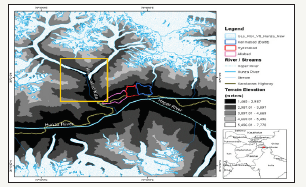- Submissions

Full Text
Environmental Analysis & Ecology Studies
Impact of Sudden Advancing of Shishper Glacier - A Case Study of Interaction between Hydrology and Natural Environment in the Karakoram Mountains
Siddique Ullah BAIG*, Karim DAD and Amjad SALIM
Department of Development Studies, COMSATS Institute of Information Technology, Pakistan
*Corresponding author: Siddique Ullah BAIG, High Mountain Research Center, Department of Development Studies, COMSATS Institute of Information Technology, Abbottabad, Pakistan
Submission: August 30, 2018;Published: August 31, 2018

ISSN 2578-0336 Volume4 Issue1
Opinion
Livelihood of about 44% or~40,000 inhabitants’, residing in five major villages of the Central Hunza, situated in the western Karakoram depends on the arrangement and dynamics of water irrigation networks. These irrigation channels transport melt-water from shishper glacier for irrigation and to generate hydro-power. Until 1986, there was little double cropping even in the low-elevation areas (e.g. Aliabad) due to rugged-terrain and inaccessibility of melt-water from this glacier, which depends upon the season, glacier fluctuation, arrangement and dynamics of water irrigation networks. Wheat, barley, millet and buckwheat were ancestral crops of Central Hunza.
figure 1:Study area.

Maize was unimportant till 1930 but maize straw become an addition for fodder demand during the winters as the glacier termini retreats in winters and ablation decreases glacier size, resulting in the desiccation of irrigation channels causing water shortages. Based on indigenous knowledge systems, several failed attempts were also made to construct irrigation channels for smooth distribution of water. However, a channel namely Hassanabad Nalla, constructed from three different termini of Shishper glacier at different time-periods were successful. Customarily, water distribution strategies based on rules promulgated by the then Mir (ruler) of Hunza could not be enforced to provide melt-water at different time-periods (i.e. winter, summer, spring) to villages lies on differ ent altitudes. This channel is able to provide water during winters, while rests of two channels connected from other glaciers remain dry (desiccated). Hence, the downstream communities’ responses to fluctuation in these glaciers and adaptation approaches have been changed. Especially, changes in land use practices (e.g. from single crop of wheat or barley to cashable potato crop) is tantamount to changing dynamics of irrigation channels or agricultural innovations (Figure 1).
This paper attempts to highlight the behavior of Shishper Glacier, based on recent hands on observations of locals including the authors who frequently visit the valley since decades. Shishper Glacier has stretched significantly towards south-west direction from north-east. Minor movements were observed for the last two years but since May-June this year, a drastic growth can be evidently observed both forward and upward. The Glacier is located in Shishper Valley in central Hunza and can be accessed four kilometers away from Hassanabad ravine (naalah). The peak rise of the glacier upwards is about 180 feet from its previous normal position. A local observer opined that its upward rise is due to the force created as the glacier hit the mountain to the south-west during forward movement.
Mochowar glacier, a parallel to Shishper (Figure 2) is positioned to the north-west and is stretched towards south- east. Both the glaciers converged into one to form a confluence in the past but since a decade, Mochowar Glacier has retreated about four kilometers. Nevertheless locals, who frequently visit the area have reported its slow upward movement again since two years back. The present distinct retreat of this glacier is linked to general trend of receding glaciers. However, elders, who have been witness to the movement for more than a half century argue that the same glacier positioned itself at the same point some four to five decades ago where it has stood today. Based on the cited observations it can be inferred that the recession is not the current behavior only rather such to and fro movement prevailed in the past as well (Figure 3).
figure 2:Confluence of shishper and monochar glaciers.

figure 3:Uplift of shishper glacier.

The surge in Shishper Glacier may be a good omen for people concerned due to retreating glaciers and their potential implications. However, the glaciers’ recent behavior has negatively affected the locals. It has put at risk hundreds of livestock which were taken into the summer pastures in both the valleys. Their return is uncertain as the trajectories leading to both Shishper and Muchowar valleys have been hampered by rough canvases created on the glacier surface due to its upward surge. In the past there was a thick layer of debris on the glacier surface which enabled people and livestock to tread upon (Figure 4).
figure 4:Debris cover part of shishper glacier.

© 2018 Siddique Ullah BAIG. This is an open access article distributed under the terms of the Creative Commons Attribution License , which permits unrestricted use, distribution, and build upon your work non-commercially.
 a Creative Commons Attribution 4.0 International License. Based on a work at www.crimsonpublishers.com.
Best viewed in
a Creative Commons Attribution 4.0 International License. Based on a work at www.crimsonpublishers.com.
Best viewed in 







.jpg)






























 Editorial Board Registrations
Editorial Board Registrations Submit your Article
Submit your Article Refer a Friend
Refer a Friend Advertise With Us
Advertise With Us
.jpg)






.jpg)














.bmp)
.jpg)
.png)
.jpg)










.jpg)






.png)

.png)



.png)






